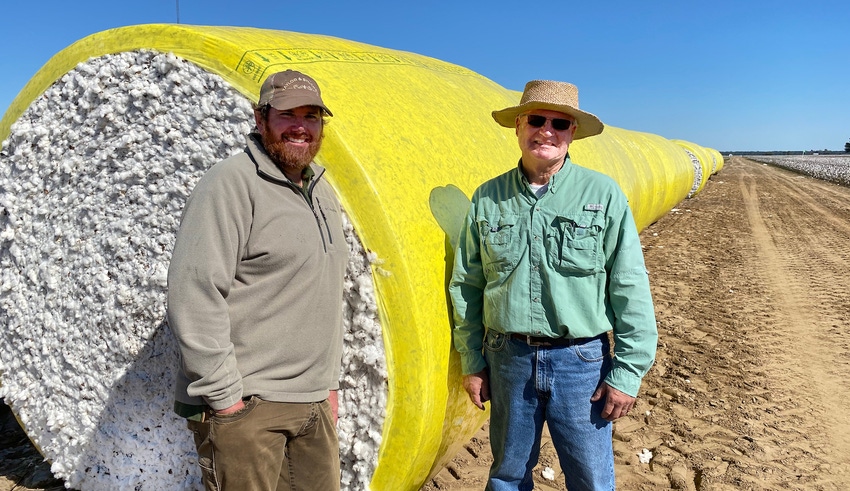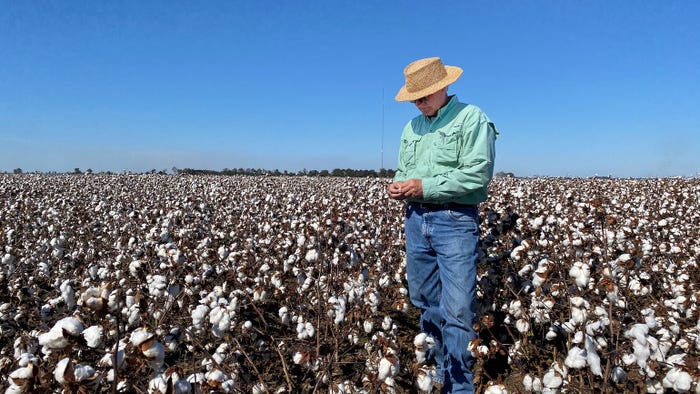
When you’ve been farming for 45 years, no one would fault you for being a little set in your ways and hesitant to change.
But that’s not Marty White’s style.
“We try to have something new every year just to see what works and what doesn’t work,” said White. “Some years we look like geniuses … and some years we don’t,” he added with a laugh.
White and his sons, Jesse Flye and Logan White, have built their farming operation to more than 14,500 acres of cotton and grain in Poinsett County, Ark. As the farm has grown, White and his sons have continued to experiment with different farming practices and even after 45 years he’s still learning new ways to increase returns.
We visited with Marty and Jesse on a Friday in October that was made for picking cotton — blue skies, plenty of sunshine, just a touch of chill in the air. On this day, they’re working with the University of Arkansas to harvest cotton variety trials. Like most everyone else, they’re ready to put 2020 behind them. The challenges of this year, especially commodity prices, reflected in some of their farming decisions.
“With cotton prices the way they are, it’s hard to make money unless you can save some,” White said.
Saving on plant populations
Thanks to their commitment to trying new things, White and Flye have found several new ways to save money in their operation over the past few years. Most recently they have experimented with lowering their cotton plant populations — from 44,000 plants per acre to 35,000 – 38,000 plants per acre.
“That ended up being a $20 per acre savings, which is a lot,” Flye said. “And it actually increased our yields. It was an eye-opening experience.”
Flye said cutting plant populations also allowed him to cut nitrogen applications down from 120 units to 90 units, creating another $15 - $20 saving per acre.
“We’ve shaved $30-40 per acre out of production the last couple of years,” said Flye. “It’s all about ROI, and that’s where we pay attention.”
Bill Robertson, Extension cotton specialist with the University of Arkansas, was on hand the day of our visit for the variety trial harvest and has worked with Flye and White on their plant population research.
“With the help of their consultant, Eddy Cates, they go through and map all their fields. They know what the plant populations are. They saw that as populations got to the 30,000s, the higher the yields across all varieties,” Robertson said.
“You can do a lot on height control with plant population, so a variety like Delta Pine 1646 that likes to get too tall, too fast — it’s just like fighting fire with gasoline by planting it too thick and giving it too much food,” Robertson said. “So, you just need to give it enough nitrogen to make the yield you want to make, but not get so big that we have to invest a lot in energy to keep the plant productive.”

Trying peanuts
One of the newest additions to the White and Flye farm is 300 acres of peanuts. The day we visit is their first full day to combine. They’re expecting a good harvest this year, and so far, White says it’s going better than last year.
“2019 was a learning experience for sure. It rained every other day, and we never saw any dust,” said White. “In fact, we were digging the combine out of the mud last year, which is something you definitely don’t want to do with peanuts.”
Despite the obstacles, they stuck with peanuts for another year, which was the right decision, according to White. One reason is lower production costs. Another, the cotton planted behind a crop of peanuts is greatly improved.
“It’s really helping our ground. We’re putting peanuts on fields where we have a lot of nematodes. Where we put it behind our fields from last year, the fields look unreal,” White said. “We haven’t picked any yet, but they look better than they’ve ever looked.”
“I’m on the board with a lot of guys in the Southeast who grow peanuts and they just say cotton behind peanuts is really good. It’ll add 100-200 pounds of lint per acre to your cotton yield. That’s pretty substantial. If you can do something one year and get that kind of increase, that’s pretty good.”
Cover crops make difference
Cover crops are another relatively new addition to the farming operation. They started looking at different cover crop blends four years ago and are already seeing improvements in weed control, moisture retention and yields, according to Flye.
“We took our worst fields and heaviest pigweed-infested fields and put cereal rye on them, and we’ve turned those worst fields into some of our highest yielding ones,” Flye said.
Flye said cover crops are also another money-saving method, despite the investment in cover crop seed.
“We’re looking at blending some different cover crops and cutting out fertilizer. And when you start cutting out those costs you can see it pencil out.”
In their latest cover crop experiment, Flye and White are evaluating a 40-acre plot with a cover crop blend of 45 pounds of cereal rye to one-pound hairy vetch per acre. They did not apply any phosphorus or potassium. They’ll compare that to a 100% cereal rye plot, as well as a plot with no cover. Flye said if it works, the savings would be significant.
“We’re looking at maybe cutting out $45 - $50 an acre on expenses on that plot of cover crop this year. Hopefully it will yield the same. Then it will really be worthwhile,” Flye said.
White agreed. “And if we can save that money, we want to know it. We won’t know unless we try.”

Always wanting to learn
The father and sons team were one of the first in their area to experiment with planting cotton into cover crops. It was on a field next to a highway, and both White and Flye recall being asked when they planned to start planting there. (They already had.)
“It scared me to death” White said.
Recalled Flye, “But then we had a big wind event and the cotton in that field didn’t get beat up.”
The father agreed. “When I was a young farmer, I would try new things and older guys would tell me, ‘That will never work.’ Sometimes it wouldn’t, but a lot of time it did,” said White. “These young guys working with me help me continue to change.”
It’s obvious White is proud of his sons. As we drive through the fields, he praises their hard work and commitment to continued improvement. He’s also quick to compliment his employees.
“I’ve been so fortunate to have good people work for me and work with me,” he said.
It’s also obvious that he wants to stay ahead of the curve, working closely with universities and industry to evaluate new crop varieties and research ways to farm better.
“I’m notorious for asking a million questions. I like asking questions. ‘What if we do this? ‘Can we do that? It’s a learning experience to have those really smart people out here, and I’m willing to listen to anyone.”
“You have to try new things and be willing to change to stay in farming.”
About the Author(s)
You May Also Like






